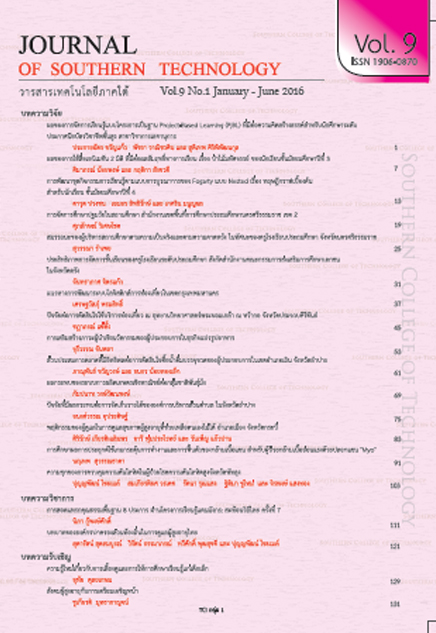การวิเคราะห์องค์ประกอบความร่วมมือระหว่างองค์กรปกครองส่วนท้องถิ่นกับศูนย์เรียนรู้ของชุมชนเครือข่ายมหาวิทยาลัยชีวิตในการจัดการศึกษานอกระบบระดับอุดมศึกษาในพื้นที่ภาคใต้ของไทย
Main Article Content
Abstract
การศึกษานี้มีวัตถุประสงค์เพื่อศึกษาสภาพและวิเคราะห์ยืนยันองค์ประกอบความร่วมมือระหว่างองค์กรปกครองส่วนท้องถิ่น (อปท.) กับศูนย์การเรียนรู้ของชุมชนเครือข่ายมหาวิทยาลัยชีวิต (ศรช.) ในการจัดการศึกษานอกระบบระดับอุดมศึกษาในพื้นที่ภาคใต้ 18 ศรช. ระยะแรกใช้การสัมภาษณ์กลุ่ม ผู้ให้ข้อมูลหลัก 4 กลุ่ม ได้แก่ ผู้บริหารท้องถิ่น ครู/อาจารย์ คณะกรรมการ ศรช. และคณะกรรมการนักศึกษา จำนวน 24 คน ระยะที่สองใช้แบบสอบถามกับกลุ่มตัวอย่าง 4 กลุ่มข้างต้น จำนวน 450 คน ผลการศึกษาพบว่า สภาพความร่วมมือยังขาดความชัดเจนทั้งในด้านวิชาการ งบประมาณ บุคลากร และการบริหารจัดการทั่วไป และเมื่อวิเคราะห์ยืนยันองค์ประกอบพบว่า มี 4 องค์ประกอบหลัก (8 องค์ประกอบย่อย 60 ตัวชี้วัด) ได้แก่ ความเป็นมาตรฐาน (มี 2 องค์ประกอบย่อย คือ หน่วยงานเป็นมาตรฐาน 9 ตัวชี้วัด และการกำหนดการแลกเปลี่ยน 17 ตัวชี้วัด) ความเป็นทางการ (มี 3 องค์ประกอบย่อย ได้แก่ การลงทุนในทรัพยากรร่วมกัน 5 ตัวชี้วัด การทำให้เป็นทางการโดยโครงสร้าง 6 ตัวชี้วัดและ การทำให้เป็นทางการโดยการตกลง 7 ตัวชี้วัด) การแลกเปลี่ยนกัน
(มี 2 องค์ประกอบย่อย ได้แก่ ระเบียบปฏิบัติเป็นมาตรฐาน 4 ตัวชี้วัด และการแลกเปลี่ยนทรัพยากร 7 ตัวชี้วัด) และความเข้ม (มี 1 องค์ประกอบย่อย คือ ความถี่ของการปฏิสัมพันธ์ 5 ตัวชี้วัด) (=0.99, 0.95, 0.94, 0.90, 0.90, 0.89, 0.75, 0.85, 0.98, 0.83, 0.64 และ 1.00 ตามลำดับ) แบบจำลองความร่วมมือระหว่าง อปท. กับ สถาบันการเรียนรู้เพื่อปวงชน (สรพ.) มีความสอดคล้องกับข้อมูลเชิงประจักษ์อย่างมีนัยสำคัญทางสถิติ
Factor Analysis of Collaboration between Local Administrative Organizations and Community Learning Centers in Non-Formal Higher Education Management in Southern Thailand
This study aims to find the conditions and confirmatory factor analysis of collaboration between Local Administrative Organizations (LAOs) and Community Learning Centers (CLCs) in non-formal higher education management in 18 CLCs in Southern Thailand. Firstly, the study was conducted by group discussion interviews, from 4 groups: LAO chiefs, teachers, CLC committees, and student committees, and secondly, gathered from questionnaires with 450 persons, from 4 groups above. The study found that the conditions still lack clear collaboration in regard to aspects such as teaching/learning, budgeting, personnel, and general management. Confirmatory factor analysis found that the components of collaboration consisted of 4 main-factors (8 sub-factor with 60 indicators): standardization main-factor (2 sub-factors included unit standardization 9 indicators, and definitional reciprocity 17 indicators), formalization main-factor (3 sub-factors included amount of resource involved 5 indicators, structural formalization 6 indicators, and agreement formalization 7 indicators), reciprocity main-factor (2 sub-factors included procedural standardization 4 indicators, and resource reciprocity 7 indicators), and intensity main-factor (a sub-factor was frequency of interaction 5 indicators) (β=0.99, 0.95, 0.94, 0.90, 0.90, 0.89, 0.75, 0.85, 0.98, 0.83, 0.64, 1.00 respectively), the linear structural model of collaboration between LAOs and Learning Institute for All was in statistically significant congruence with empirical data.
Article Details
-
Authors must agree to the journal publication rules and allow the editors to edit the manuscripts for publication.
-
Author’s right belongs to the author but Journal of Southern Technology holds the right of first publication and thus allow readers to use the article for the purpose of education but not commercial.
